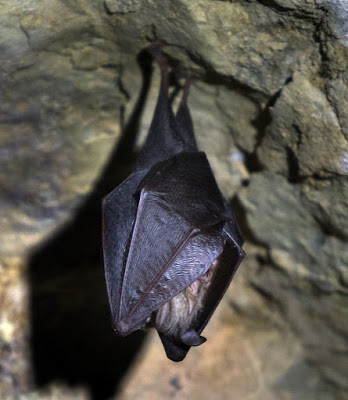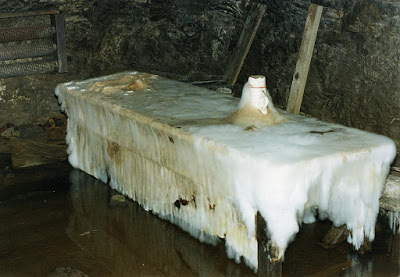The three types of cave dweller.........
The three types of cave dweller.........
Of the 16 species of UK bat, six use underground sites in North Wales: Daubenton’s, lesser horseshoe, brown long-eared, Natterer’s, Brandt’s and whiskered bats.
In addition, Dr Henry Schofield, conservation programme manager for The Vincent Wildlife Trust states that "Greater horseshoe bats are now recorded as summer residents in North Wales and it seems only a matter of time before breeding colonies are found in the area".
North Wales has 10,000 lesser horseshoe bats of the UKs total population of 17,000, despite being their most northerly stronghold. Although rare or non-existent in many UK areas, lesser horseshoes are frequently seen underground in this area where their population has been increasing since 1999. They hang from the roof in caves and mines and are easily seen, whereas the other five species tend to hide in crevices or under boulders.
Bats live for up to 15 years and hibernate between October and April, when their body temperature can drop to as little as 2 degrees centigrade and their heart beats just 10 times a minute. If disturbed during hibernation, they wake slowly. Over half an hour their body temperature rises from an average of around 10C. to 20C. and their pulse increases from about 20 to 600 beats a minute. This uses large reserves of energy, stored as fats, and is energy they struggle to replenish. Hence the need to avoid disturbing them with noise or lights.
All UK bats are protected by UK and EU legislation on the grounds that many are reported to be declining in numbers, some being classed as being 'endangered'.
The
monitoring of species, numbers and locations is carried out by the amateur sector;
by Clwyd Bat Group and Sam Dyer Ecology, both being answerable to Natural
Resources Wales (NRW). Data on bats however, is not released to the public, it
being classed as 'sensitive'. An annual report is available to the public however, which does provide
a snapshot of species numbers and distribution (see Sources below).
Several underground sites in North Wales have been fitted with 'bat grilles' by NRW to minimise disturbance, although it should be noted that even authorised monitoring by licenced inspectors can have a damaging effect on numbers: "In Britain, Stebbings (1965) has shown that 5 visits per winter were sufficient to reduce the number of bats by 50%, even though they were not subject to excessive disturbance. When interference, ringing especially, was minimised, by reducing visits to 1 per winter, the bat population increased over a period of 4 years." (Yaldon & Morris [1975] see Sources below).
Bat threat to future caving?
It has long been NRW policy that caver access to sites containing bats be restricted to their waking months between April and September. In recent years however, a new EU Directive states that no access should be permitted to a cave with bats at any time of the year. This has already been shown to affect archaeological work in North Wales, where Clwyd Powys Archaeological Trust had to abandon their work at more than one cave site during the summer months. Knowing how rigidly NRW adhere to regulations, it may only be a matter of time before caving is outlawed. This may seem alarmist, but NRW have consistently been unwilling to engage with local caving clubs, on any subject, and this EU legislation could provide them with a convenient means of exclusion.
Clwyd Bat Group
Although the main local organisation is Clwyd Bat Group, they cannot be regarded as a helpful organisation. The only contact provided by their website is by email, but enquiries using this are regularly ignored. To quote their Mike Castle a few years ago "I don't have time to answer emails". Sadly the group continues to ignore bona fide enquires via email (in 2019).
Sources
Yaldon & Morris (1975): "The Lives of Bats" is an excellent book on the topic, available second hand for around £8: https://www.abebooks.co.uk/servlet/SearchResults?sts=t&an=&tn=the+lives+of+bats&kn=1975&isbn=&n=100121503
Although Clwyd Bat Group do not provide the public with data, the Joint Nature Conservation Committee (JNCC) and Bat Conservation Trust are happy to share their "National Bat Monitoring Programme - Annual Report 2018" online: https://cdn.bats.org.uk/pdf/Our%20Work/NBMP/National-Bat-Monitoring-Programme-Annual-Report-2018.pdf?mtime=20190509100258
Cambrian Caving Council provide an excellent guide to UK bats (from which much of the above information was taken): http://www.cambriancavingcouncil.org.uk/cavelife/wales/bats.html
An
early North Wales bat survey was carried out between the years 1960 and 1967
by Lynx Cave excavator John Denton Blore. Although his detailed account is currently only in hard copy, if a few people are interested, the writer will digitise the report. Get in touch at: cavecomment@hotmail.co.uk.
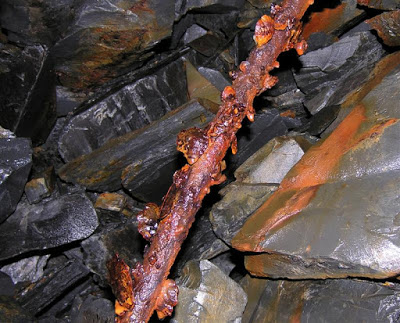
When on your next caving trip, why not spend a little time looking for life-forms of any kind and if possible, take close-up photos or collect samples to have identified and recorded.
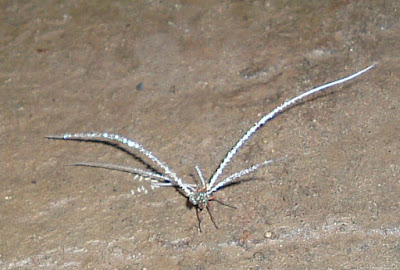
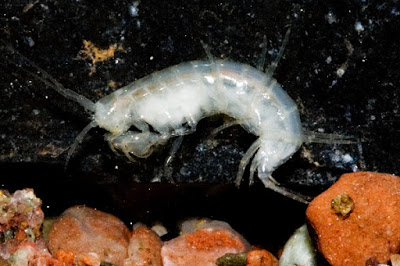
Two factsheets are available from BCA as downloadable PDFs: 'White Nose Syndrome in Europe' and 'Bats Underground': https://british-caving.org.uk/wiki3/doku.php?id=conservation_access:bats
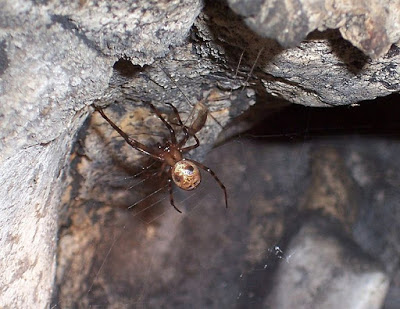
Source: http://en.wikipedia.org/wiki/File:Meta_menardi.jpg
It is one of the Opiliones or Harvestmen, easily recognisable by the way that at rest it holds its leg out at right angles to the body and that the pedipalps are forked.
Thus its species is Dicranopalus ramous, which is actually a recent invader from Morocco.
